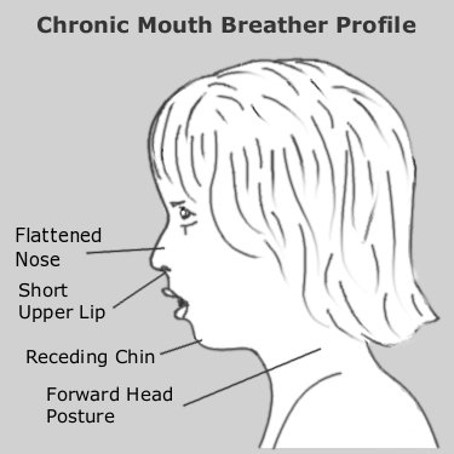“The mind is the king of the senses, and the breath is the king of the mind.” BKS Iyengar
Mouth Breathing
It is perfectly natural to breathe through your mouth at certain times, such as when lifting a heavy load or exercising. Breathing through the mouth as the primary source of breathing can cause health problems. These problems can be especially severe for children because it can affect the long-term development of the face. Most of us bring air into our body through our nose. The nose is designed to act as a natural humidifier and filtering system for the air we breathe. Ideal breathing is in and out through the nose. When we can’t get enough air through our nose, however, the mouth takes over. Breathing through the mouth most of the time was not nature’s intent. When this happens, problems can occur.
Why Would Someone Mouth Breathe?
Mouth breathing is a postural habit that can develop for numerous reasons. Below are the most common:
Allergies
Thumb or finger sucking habit
Low tongue posture
A physical restriction in the tongue
Enlarged tonsils or adenoids
Chronic nasal congestion
Respiratory infection
Each of these factors or a history of any one of them make it physically difficult for a person to nasal breathe. If nasal breathing is not possible, the body’s only choice is to mouth breathe. The body can only live a few minutes without oxygen, so utilizing the emergency access hole (the mouth) allow you to continue to live, but without all the other benefits of nasal breathing.
Mouth breathing changes the way the tongue works; it can develop into low tongue posture, or an abnormal swallowing pattern commonly known as a tongue thrust. A tongue thrust affects speech, swallowing, breathing, and chewing in problematic ways.
Benefits of Nasal Breathing
There are many benefits to nasal breathing:
Air is filtered to removed: dust, dirt, pollen, dander and other allergens.
Nitric oxide is produced in the nose that kills bacteria and viruses, increases blood flow, allows for better oxygen absorption in the lungs.
Moisture is added to the air before it reaches the lungs.
Temperature and speed is adjusted to make it easier for the lungs to utilize the air.
Improves lung volume.
Allows for diaphragmatic breathing.
Activates parasympathetic (calming) nervous system.
Decreases anxiety.
Makes you less likely to cough
Improves athletic performance
Facial Growth and Development
Breathing through your mouth can change the shape of your face and alter your appearance. This is especially true for children because they are still growing.
Children whose mouth breathing goes untreated may suffer from abnormal facial, dental and neurological development. Symptoms include long, narrow faces and mouths, less defined cheekbones, small lower jaws, and “weak” chins. Other facial symptoms include gummy smiles, crooked teeth and smaller airways. Mouth breathing in children will often lead to a lifetime of sleep disordered breathing, snoring, and sleep apnea.
What Can Be Done to Treat Mouth Breathing?
Mouth breathing may seem like an easy habit to change. Just close your mouth, right? Unfortunately, for people who struggle with mouth breathing, it is not that easy. This is because habits can be difficult to change. All of the muscles—the tongue, lips, cheeks, etc—have learned to function in an “incorrect” way. The body does not actually know how to breathe normally, through the nose, and the nasal passages do not work efficiently in most cases either. In order to stop mouth breathing, the muscles must be “re-trained” to function in new ways. If the muscles are not re-trained, problems with general health, speech, orthodontic treatment, dental health, sleep, swallowing and breathing may persist throughout life.
How long does it take?
Dave is skilled at helping children and adults gain control over muscle patterning habits, including those involved in mouth breathing. Dave has specialized training from the MyoMentor Institute, The Breathe Institute and Buteyko Clinic International to guide you on your journey to find health through nasal breathing. He will will evaluate your facial and tongue muscles and develop a treatment plan specific to your needs. Typically you can plan on 12-14 therapy sessions with a few minutes of practice exercises each day. You can set up a consultation and evaluation to determine the severity of your symptoms and recommended treatment.




